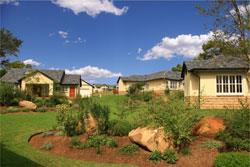Waterfall Country Estate near Sunninghill in Gauteng is the first mixed-use development in the country that follows basic environmental guidelines.

Waterfall Country Estate near Sunninghill in Gauteng is the first mixed-use development in the country that follows basic environmental guidelines.
Developed by Century Property Developments, the estate is able to reduce the overall carbon footprint by up to 60 percent, says chief executive officer, Mark Corbett.
He explains that every aspect of the development is scrutinised to help it achieve this ambitious target.
These include architectural design, the creation of extensive green belts and landscaping using indigenous plant, recycling rain and storm water and piping liquid petroleum (LP) gas to all homes on the estate.
“The motivation for greening makes good economic sense and 30 percent of new home buyers cite environmental issues as among the most important reasons for choosing to purchase property at Waterfall Country Estate.”
He says through these green initiatives at the development, they are able to show that by moving to a green estate where one substantially reduces carbon footprints, they will save money both in the short and long run.
He notes that Century Property Developments is one of the first residential developers in the country to offer piped LP gas to all homeowners.
This will provide about 70 percent of each home's energy requirements and currently, LP gas is about 30 percent cheaper than electricity.
The Century gas installation in conjunction with Sasol Home gas will reduce the carbon footprint by 40 to 50 percent on affected homes.
The price advantages will grow in the coming years once the Eskom tariff increases that have been approved kick in and LP gas prices are expected to increase at a much slower rate than Eskom tariffs.
Corbett says initially, the gas network will feed Waterfall Country Estate and Helderfontein Estate in Fourways, but will then extend to all Century Property Development estates.
On completion, Waterfall will be the biggest LP gas network in the southern hemisphere.
The advantages of the LP gas network are an environmentally-friendly green fuel that offers homeowners a significant cost saving to their overall energy bills, he says.
Eskom load shedding will become a feature of life in South Africa once again over the next few years as Eskom generating capacity comes under renewed strain.
Those with gas piped to their homes will be protected to a large degree from this eventuality, says Corbett.
“It's not just load-shedding that will disrupt life for many across the country, but the cost of electricity will add to the cost of maintaining a household.”
Another way Century Property Developments is reducing its carbon footprint is by erecting recycling plants to capture, clean and reuse rain and storm water.

The development makes use of indigenous plants grown at its in-house nursery, the largest of its kind in the country. Indigenous nectar- and berry-bearing species attract a stunning variety of birds throughout the year, adding a new and interesting dimension to the estates.
Then there are the more obvious greening options available to home owners, such as solar-powered geysers, energy-saving appliances and energy-efficient architectural design.
“A house built according to our sustainable housing guidelines will have a minimum 40 percent lower carbon footprint than the average residential house in Gauteng.”
The development makes use of indigenous plants grown at its in-house nursery, the largest of its kind in the country.
Indigenous nectar- and berry-bearing species attract a stunning variety of birds throughout the year, adding a new and interesting dimension to the estates.
These include a carefully selected balance of evergreen and deciduous (which lose their leaves), fast and slow-growing, flowers, fruits and foliage.
“The use of indigenous species, apart from the obvious aesthetic appeal, uses just 10 percent of the water used by exotic species.”
Home designs and aesthetic aspects of the estates are uniquely South African, says Corbett.
An aesthetics committee protects the integrity of each estate and strongly encourages the use of materials in their natural state only.
These materials are raw stone, exposed brick, plaster, glass, wood and steel while paints are often limited to cement finishes and colours may only be earth-tones.
Homeowners are also expected to play a key role in reducing their overall carbon footprint, by incorporating awareness of environmentally sustainable design principles and expressing such preferences to their architect, designers and builders which can bring about significant change across the industry.
The main ways that homeowners are expected to make a difference is through:
- recycling of refuse
- saving energy through the use of solar geysers and energy saving lighting
- using passive climatic design or 'green' architecture
- storm water capture
- responsible landscaping
We believe it is our moral obligation to start thinking not only smarter but ‘greener’ by introducing certain key initiatives that will ensure a minimal impact on the environment while simultaneously creating long-term cost savings, adds Corbett.








